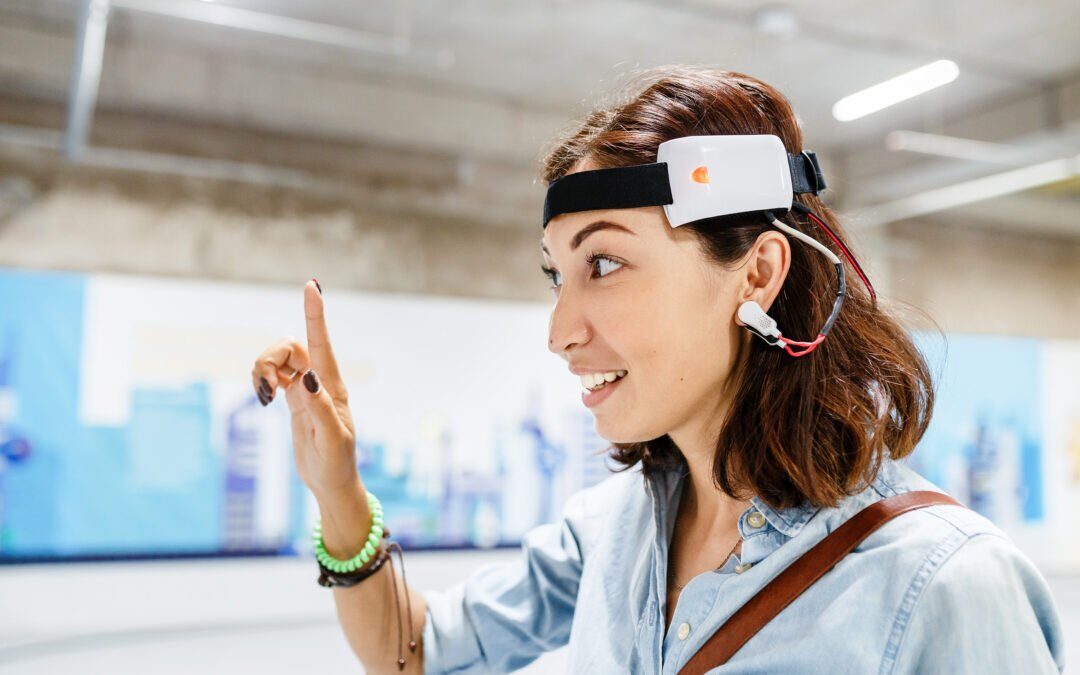It’s so hard to pick my favorite projects! Each project we do has been a wonderful adventure of teamwork, innovation, and community engagement that it is so hard to pick just five to highlight, so what I have selected represent “firsts” in my work in wearables for health:
PlayskinLift Project
My work in wearable technology really began with the PlayskinLift project, under the supervision of my advisor Dr. Michele Lobo. Dr. Lobo is a pediatric physical therapy professor at the University of Delaware.
At the time of the project, she was a research scientist for Dr. Cole Galloway, the founder of GoBabyGo. Dr. Lobo’s research focuses on improving physical and mental development of babies and toddlers with limited arm movement. When a child has limited ability to move, explore, and play, they are at risk for developmental delays. Unfortunately, there is little assistive technology available to help these kids move their arms.
Dr. Tariq Rahman at AI DuPont Children’s hospital developed an assistive device for this purpose for young adults. Called the WREX (Wilmington Robotic Exoskeleton), this device attached to a wheelchair or body brace and facilitated arm movement.

Dr. Lobo collaborated with Dr. Rahman to develop a 3D printed version for babies & toddlers, however, they soon discovered that the children did not like wearing the exoskeleton.

At the time, I had joined the GoBabyGo lab as the resident fashion designer and worked with a team of student engineers to help solve the problem and redesign the device. Instead of miniaturizing the WREX, we took a more kid-centered approach: what do kids already wear? Onesies!

We developed the first exoskeletal garment that worked as both an assistive and rehabilitative device for children with limited to no ability to independently move their arms against gravity.
The device worked very well – children were comfortable wearing the garment and it helped them explore their world! The first time I saw the new garment (the PlayskinLift) help a child move, I was overwhelmed with joy and a feeling of purpose that I had never felt before.
I knew in that moment that designing and building wearables that helped improve lives would be my life’s work. There was just no going back to typical Fashion Design. From then on, I would work on Functional Fashion.
Adaptive Jeans Project
The Adaptive Jeans Project was my first independent project as a doctoral student. I wanted to have my dissertation project feel meaningful, just like the PlayskinLift project felt. However, unlike the PlayskinLift project, I wanted to engage the end-users (kids with disabilities) directly – what did they need?
I wanted to work with older kids so I could speak with them directly – what challenges did they and their families face each day? Was there an opportunity in those discussions to create a wearable for these kids that improved their movement or quality of life? I spent a year talking with kids and their caregivers – kids with all kinds of physical and mental challenges: from cerebral palsy to Down syndrome.
These families all reported the same issues – challenges with activities of daily living. Activities of daily living (or ADLs) are the basic tasks we all need to do each day in order to live, including bathing, going to the bathroom, eating, etc.
All of the families told me that getting dressed and undressed independently was the number one daily challenge. Being able to dress/undress yourself facilitates so many other things – from being able to go to the bathroom without help to being able to wear any clothing you want.

Many children with these conditions typically wear sweatpants or leggings, primarily due to the ease with which they can be put on, worn, and taken off. I discovered that all the kids just wanted to wear the same clothes as their friends. All the kids wanted to wear jeans. Typically, jeans are difficult to wear; they are made from stiff fabric, they have zippers which are hard to work and they are designed to fit a “typical kid.”

For my dissertation, I created a line of user-centered jeans – jeans made with soft stretchy fabric, jeans that featured magnets rather than zippers & buttons, and jeans that were custom fit for every body shape and size, and jeans that had varied openings and designs specific to the child. This project led to me developing the 5F Framework™ and a soon-to-be announced major collaboration with a global leader in children’s clothing.
Step4Life™ Project
The Step4Life™ project was a milestone for me because it represents my first patent. The project was inspired by a young man I met who was very active – he was into playing basketball, swimming, and hockey. His asked his mom for an activity monitor to keep track of his “steps” – however he had a physical disability which made a traditional commercial activity monitor ineffective.

Traditional activity monitors count “steps” from an algorithm based on arm movement. If a customer does not have a typical arm swing while they are walking, then the monitor does not accurately count steps. This challenge inspired me to create a wearable that would count actual physical footsteps in real time AND let the wearer know in a fun way that they achieved their goal.

I designed and constructed a textile-based conductive switch that, when placed under the foot, counts real-time footsteps. The device can be programmed for a specific step count goal with any output, such as a LED that lights up green when the goal is reached!
Body Scanning Initiative
The fashion industry bases clothing sizes and shapes on an ‘ideal typical’ body during a specific time period – the ideal body shape changes for men and women depending on the time in history, but one thing remains the same: the ideal body is always based on a “normal” body. A “normal” body is a typical, healthy body; one that is considered the most attractive shape for the time and is also fully functioning and without impairment or disease.
From time to time we all experience the challenge of finding clothes that fit and express our sense of self. If you have a disability, whether that be physical or mental, it can be extremely challenging to find clothing that fits well, is easy to get dressed & undressed in, is comfortable, AND feels like your sense of style! Sizing standards and clothing design features are not based on the needs of those individuals living with disabilities.
For this reason, I am proud to highlight a partnership with Human Solutions, Inc. to revolutionize and democratize the fashion industry. How? Through a body scanning initiative designed to create additional sizing standards.
We are scanning individuals with a variety of physical and mental challenges, such as individuals with Down syndrome and individuals with Spina Bifita, that affect clothing fit. In partnership with Human Solutions, a global leader in 3D scanning and sizing standards, we can create new standards that are inclusive to ALL bodies.

I am thrilled to be in collaboration with this innovative company to eliminate barriers and facilitate EVERYONE to have clothing that fits, functions, and is fashionable!
M.A.M.A.
The MAMA project is the last project I want to highlight as a favorite because it was the first project inspired and led by one of my students: Gabriella Zarlenga. Gabriella came to the Innovation Lab as an inspired volunteer. She was studying Medical Diagnostics at University of Delaware and hoped to someday be a NICU nurse. The NICU or Neonatal Intensive Care Unit, is the hospital wing caring for pre-term and/or medical fragile newborns. Gabriella had spent time shadowing nurses in the NICU and had noticed that some of the babies in the NICU, due to their fragile condition, are not able to receive kangaroo care.
Kangaroo care is the practice of newborns having skin-to-skin contact with a parent for a given amount each day to help regulate the baby’s breathing, heart rate, and body temperature. Gabriella was inspired to create a device that simulated skin-to-skin contact for babies not eligible for traditional kangaroo care. She asked me if she could create her own project, based on this health problem, as a volunteer in the Innovation Lab.
I was thrilled to support Gabriella and what became her team of student colleagues. With the help of multiple engineering students and students in the health sciences, Gabriella created MAMA:

By introducing the Midline Alignment Medical Apparatus (MAMA), a silicon model of mother’s torso with strategic curves and cutouts to maintain baby’s C-spine, we can provide both the benefits of midline alignment and skin to skin contact at the same time. Our “MAMA ” breathes, has a heartbeat and has skin that feels like a real mother. The system would be built around a microprocessor that would control the simulated respiration rate and heartbeat of the infant “virtual caregiver” to make it similar to that of the babies’ own mother.
Conclusion
These 5 projects have been exceptional, illuminating, and wonderful to work on. What I learned working with numerous fantastic teams and visionaries has been invaluable and the work we’ve done will improve the lives of many children in need.
As I work on future projects, I’ll be detailing the work and its impact here, so if you have enjoyed this blog please subscribe. Thanks for reading and I hope this inspires you to get out there and innovate!

